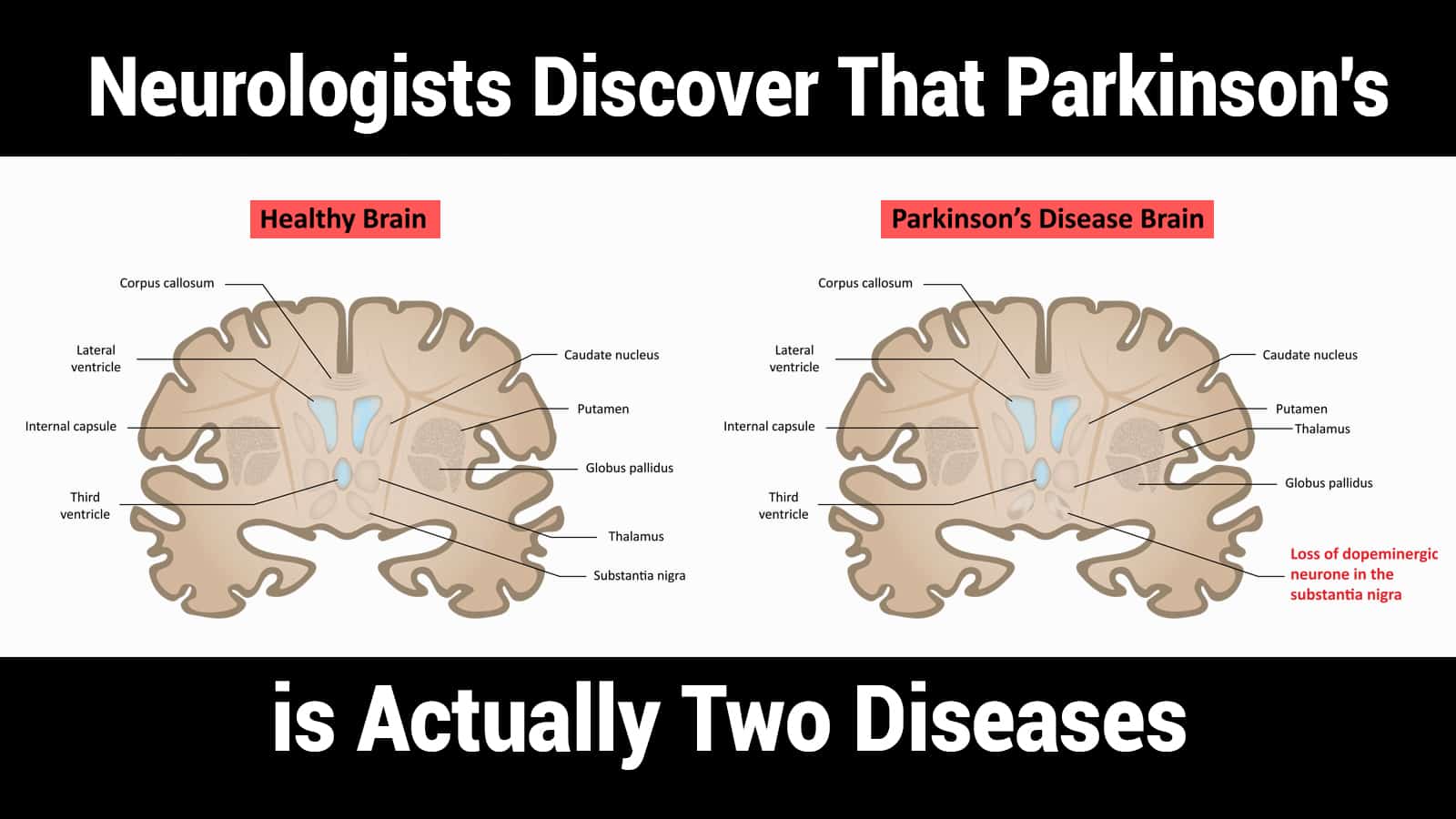Every year, around eight million people worldwide are diagnosed with Parkinson’s disease. In the United States alone, it’s estimated that 60,000 people will be identified as having Parkinson’s this year. New research reveals that Parkinson’s disease can start in different places in your body, leading researchers to believe that it’s not one disease, but two. Here’s what neurologists are saying about why they think Parkinson’s is two diseases.
Now, Danish researchers at Aarhus University Hospital say Parkinson’s might actually be two diseases, not one as previously thought. This emerging information can help doctors craft more specialized and patient-centered treatments to meet the specific attack of the disease.
Researcher Per Borghammer says the following about their discovery:
“With the help of advanced scanning techniques, we’ve shown that Parkinson’s disease can be divided into two variants, which start in different places in the body. For some patients, the disease starts in the intestines and spreads from there to the brain through neural connections. For others, the disease starts in the brain and spreads to the intestines and other organs such as the heart.”
As the research continues, this groundbreaking news has the potential to offer more targeted therapies to slow the advancement of the disease.
What is Parkinson’s disease?
Parkinson’s is a disorder of the human nervous system. It grows worse over time, leading to cognitive decline. The nerve cells in your brain get weak, damaged, or die, causing stiffness, tremors, or imbalance.Recent studies found that in some Parkinson’s patients, this disorder begins in the brain and spreads to the intestines, then to other organs. In other patients, it starts in the intestines, then spreads to the brain. This discovery is significant because it will help doctors know how to treat each patient depending upon where their disorder starts.
As Parkinson’s disease symptoms grow, you may have trouble walking, talking, and doing regular household tasks. There’s currently no cure for Parkinson’s disease, but with these new findings, researchers can determine if genetic factors affect both types of the disorder. They can also figure out how to best treat a patient’s intestines to prevent the spread of the disease to their brain. The difficulty though, is diagnosing the disorder soon enough since most patients are symptom-free until they have trouble walking or moving. By this time, the patient has already lost half of the dopamine system, the neurotransmitters that help your nervous system send messages to your nerve cells resulting in cognitive decline.
What are the symptoms of Parkinson’s disease?
The symptoms of Parkins begin slowly and get worse over time. Here’s a list of symptoms and signs you may experience if you have Parkinson’s disease.
Tremors
You may notice your hand, finger, or thumbs trembles while at rest. Some people experience tremors in their face, foot, or jaw. These tremors are typically only one side of your body. These tremors are a back-and-forth movement. It shows up mostly when you’re stressed or tired. When you move, the quake may go away until you stop and rest again.
Trouble smelling
Another typical Parkinson’s symptom is the lack of smell. You may find that you can’t smell foods with a distinctive odor that you usually can smell like bananas, coffee, or dill pickles. This is often an unrecognized symptom that may go on for years before you’re diagnosed with Parkinson’s disease.
Trouble sleeping
Trouble falling asleep, jerking movements while sleeping, or acting out dreams is another early sign of Parkinson’s disease. This is difficult because everyone has trouble sleeping once in a while. The most significant symptom, though, is the jerking movements of your body while sleeping. If you’re experiencing these symptoms, speak with your doctor. Several other diseases are linked to insomnia, so it’s worth getting checked out.
Stiffness
Stiff arms, legs, or body can be a significant symptom of this disorder. You may notice that as you walk, your arms don’t swing naturally. The stiffness may go away as you move, then return when you’re resting. Some people say their hips and shoulders are incredibly stiff. They explain it as, “my feet are stuck to the floor” type of symptom.
Changes in your voice
If people are telling you that your voice sounds different, it could be a symptom of Parkinson’s. Voice changes such as softness, hoarseness, mumbling, or breathiness are common symptoms. Ask your family or friends, especially about this. Do you have a cold or sinus infection? Some voice changes are the result of a thyroid disorder. Contact your doctor if these symptoms continue, since there are various disorders with these types of symptoms.
Changes in handwriting
Smaller handwriting than you used to have or a change in the way you write, such as crowded lettering or letter size changes, are all early symptoms of Parkinson’s disease. These Parkinson’s symptoms occur because of changes in your brain that cause you to have a hard time controlling your hand movements. It affects your fine motor skills. Keep an eye on this symptom, since it could be the very early stages of neurological changes due to Parkinson’s disease.
Constipation
Constipation and straining in your bowel movements is another primary symptom of Parkinson’s disease. Like other common symptoms that people experience, this one gets overlooked by people. This symptom isn’t usually connected to Parkinson’s until the patient experiences motor control issues such as stiffness and tremors.
Slouching posture
If you’re starting to lean forward or have a slouching posture, you could be in the early stages of Parkinson’s disease. If your friends or family mention that you appear stooped over, you may want to speak with your doctor. The physician can order tests to see if you, in fact, have Parkinson’s disease.
If you notice these symptoms in yourself or if someone you love has these symptoms, don’t hesitate to see your doctor. If possible, you can visit a neurologist who may have more experience with a neurological disease like Parkinson, so they can diagnose it quicker. Don’t overlook these symptoms or find excuses to ignore them, especially if they increase in frequency. The sooner you’re diagnosed, the sooner your specialist can find the best treatments to slow down your disease.
Stages of Parkinson’s disease
Not everyone has the same symptoms of Parkinson’s disease. They vary from person to person. But once you’re diagnosed, you will generally see a progression of the disease in stages.
Stage 1
In this stage, you may have mild symptoms that don’t interrupt your daily life too much. You may have tremors or moving problems on one side of your body. Some patients complain of posture changes or body or facial stiffness.
Stage 2
Your tremors, movement problems, and rigidity are getting worse and on both sides of your body. You may experience walking difficulties and poor posture. Your daily tasks are more complicated by now, but you can still get around okay.
Stage 3
By the time you’re in this stage, you will have a loss of balance and slowness in your movement. You may fall, and by now, you’re growing in your dependence. You’ll need help to dress and eat. You may want to use a cane to walk, so you don’t fall.
Stage 4
At this stage, you are experiencing minimal movements. You must walk with a walker or sit in a wheelchair. It’s best if you don’t live alone because you’ll need help to dress, eat, and to get around.
Stage 5
This is a debilitating stage. Your stiffness is constant, so it might feel impossible to walk or move around. At this stage, you’re fully in a wheelchair. You may become bedridden soon. Some Parkison’s patients need a full-time nurse by this stage. You may experience hallucinations or delusions. Memory loss is also another common symptom due to your cognitive decline.
What the new research means to Parkinson’s Disease patients
Until recently, researchers viewed Parkinson’s Disease as a well-defined disease based upon movement problems. But they were curious to know why there were so many symptoms experienced by patients. This new understanding of different origins of the disease could lead them to future discoveries for treatment and diagnosis.
The two types of Parkinson’s are called”body-first” and “brain-first.” The body-first Parkinson’s disease researchers are hoping to study bacteria in their intestines. Different bacteria or microbes in the intestines could be an indicator of the disease. They also wish to study genetic factors that could play into the two types. The brain-first variation of Parkinson’s disease may be harder to diagnose since the patient can be symptom-free for years until they begin to have tremors or walking problems.
Final thoughts on Parkinson’s Disease being two separate entities.
New findings of Parkinson’s disease reveal the answer to the question researchers have been wondering about for years–why Parkinson’s patients experience so many varying symptoms. This research shows this is because there are not one, but two types of Parkinson’s disease as a neurological disorder. The brain-first type of the disease originates in your brain while the body-first starts in your body then travel to the brain and other organs such as the heart.
Researchers hope these distinctions of the two separate conditions will help diagnose and treat Parkinson’s patients sooner. If you are experiencing any of the above symptoms of Parkinson’s, be sure to see your doctor. They will order tests to determine the cause. You’ll find comfort knowing exactly what’s going on in your body. And thanks to this new understanding of the disease, the future for Parkinson’s patients appears more promising.
















 Community
Community

